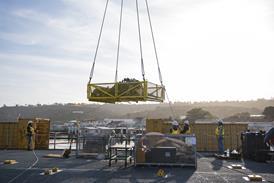
Graham Warwick/WASHINGTON DC
The US Federal Aviation Administration has produced a new blueprint for modernisation of the country's airspace system, but industry remains far from convinced that the document represents a firm timetable for the introduction of new technologies.
Manufacturers have been researching the new communications, navigation, surveillance and air traffic management (CNS/ATM) technologies required for free flight for several years, but remain reluctant to commit to developing products until there is more detail in the FAA's planning.
Operators, meanwhile, remain sceptical that the FAA will deliver the planned improvements on the projected schedule. They are reluctant to incur the cost of equipping their aircraft with the new technologies unless there are guarantees that the promised benefits will materialise within the planned timescale.
Recognising that its record of delivering improvements on schedule is not good, the FAA has agreed with industry a modernisation plan which it believes will reduce the costs and risks while delivering early user benefits.
The new blueprint is called the National Airspace System (NAS)Architecture 1998, and replaces the previous modernisation plan, Version 3.0, which was deemed too ambitious and expensive. The new baseline NAS architecture envisages a phased modernisation leading to the goal of free flight - defined as "-a safe and efficient flight operating capability-in which the operators have the freedom to select their path and speed in real time."
The NAS Architecture 98 blueprint lays out a 15-year modernisation plan and divides the transition to free flight into three phases:
Phase 1 (1998-2002) - implement limited free flight prototypes; Phase 2 (2003-2007) - begin the transition to free flight; and Phase 3 (2008-2015) - achieve limited free flight operations.The elements of what is now called Free Flight Phase 1 have been agreed by the FAA and industry, represented by advisory body RTCA. This first phase is a modest step towards free flight, and focuses on the limited deployment of prototype decision-support systems at selected locations to help controllers' sequence and separate traffic more efficiently.
The significance of Free Flight Phase 1 is that the cost to operators is minimal, as no new avionics are required. Because of this, there is also no incentive to equip with new avionics - and concerns about the willingness of operators to embrace the new free flight technologies are among the many "watch items" in the FAA's modernisation blueprint.
Later modernisation phases do require significant outlay on new avionics, and operators are urging the FAA to include cost/benefit analyses in its plans to assure them that investment in free flight technologies will result in benefits that quickly offset expenses.
A key to providing those assurances is the planned Flight 2000 demonstration, now renamed the Free Flight Operational Enhance-ment Programme. As restructured by the FAA and RTCA, this programme will demonstrate nine operational capabilities for free flight, most of them requiring new avionics. A detailed plan is expected by year-end, and the demonstration is planned to be conducted between 1999 and 2004 in Alaska and the Ohio valley.
This dovetails with the FAA's plans to begin the transition to free flight in Phase 2 of the NAS modernisation. Here the avionics implications begin to be significant. Whereas Free Flight Phase 1 will involve only a limited trial of controller-pilot datalink communications (CPDLC), in Miami or Minneapolis, national deployment will begin in Phase 2. Automatic dependent surveillance - broadcast (ADS-B) will also be introduced during Phase 2, as will VHF datalink (VDL) and digital radio (VDR).
There still significant technological uncertainties about the later phases of modernisation. however. These include questions about the type of datalink to be used for ADS-B. The FAA plans to use a 1,090MHz datalink, in the frequency band now used for the Mode S transponder and the traffic alert and collision avoidance system (TCAS). Industry, however, is watching European development of a VHF datalink, known as Mode 4, for ADS-B and is concerned that this could become the international standard.
The FAA says it will evaluate and select ADS-B technologies during Free Flight Phase 1, but that it intends to pursue the 1,090MHz datalink for TCAS-equipped aircraft and "-let the [aviation] community decide on other technologies". Industry, however, would rather see just one datalink technology being adopted for ADS-B and is concerned that pursuit of the 1,090MHz solution will see the US falling out of step with the rest of the world.
BACKUPS REQUIRED
There are also questionmarks over the FAA's plans to make the transition to satellite-based navigation and landing systems. In its new modernisation blueprint the agency, for the first time, accepts that some ground-based navigation and landing aids will have to be retained indefinitely as backups. This is because of concerns over the susceptibility of global positioning system (GPS) signals to unintentional interference and intentional jamming.
It is now unlikely that GPS will be approved for sole-means use in the foreseeable future, even when the wide-area augmentation system (WAAS) becomes operational next year. While GPS/WAAS will be approved for primary- means use, operators will be required to use ground-based navaids as backups. This will limit the cost benefits of GPS, as the FAA will have to retain one-third of its ground-based navaids and operators will have to retain at least a single set of backup avionics.
Industry now questions whether there is any economic benefit for operators to equip to use GPS/WAAS in the near term. That may begin to change when a second civil GPS frequency becomes available, reducing its susceptibility to interference, and when deployment of local-area augmentation systems (LAAS) gets under way. In addition to providing precision approach guidance, LAAS will increase the availability and integrity of GPS, and industry is now looking at extended-range LAAS as a way of allowing sole-means use of GPS.
Despite these criticisms, the FAA's new blueprint for NAS modernisation has been welcomed by the US aviation community as a major step forward. Its importance lies in the fact that the phased approach is broadly supported by the industry. This consensus means that the FAA is more likely to get the funding required from Congress.
BLUEPRINT FOR FREE FLIGHT
Contained Within the NAS Architecture 98 modernisation blueprint are transition plans for each of the key elements of the US airspace system, over the three phases (Phase 1: 1998-2003; Phase 2: 2003-2007; and Phase 3: 2008-2015) leading to free flight. The transition events which have avionics implications are as follows:
Phase 1 - WAAS becomes operational for en route navigation, non-precision and precision approaches; operational restrictions are removed as additional ground stations and geostationary satellites are deployed. Phase 2 - LAAS is deployed at some 150 airports to provide Category 1-3 precision approach capability; the FAA and the aviation community determine the schedule for the gradual reduction of ground-based navaids. Phase 3 - transition to WAAS/LAAS, with about a third of ground-based navaids being retained as backups.Navigation watch items include: WAAS performance and acceptance by users; policies on redundant equipage; availability of affordable certificated avionics; and user equipage rates.
Phase 1 - implement initial CPDLC message set via VDL Mode 2; Phase 2 - begin VDL Mode 3 digital voice operations in high-altitude en route sectors; and expand CPDLC message set; Phase 3 - move to digital radio for all instrument flight rules operations, with VHF analogue voice retained for general aviation.Communications watch items include: user equipage with VDL Mode 2 and Nexcom digital radios.
Phase 1 - evaluate and select ADS-B air-to-air technologies with the aviation community with "1090 squitter" to be available for TCAS-equipped aircraft from mid/late 2000. Phase 2/3 - long-term implementation of air-to-air and air-to-ground ADS, with deployment at some 900 ground stations beginning around 2006.Surveillance watch items include: evaluating the benefits of ADS for air traffic control; and user equipage rates with ADS-B avionics.
Phase 3 - complete transition to WAAS/LAAS; extend use of ADS-B throughout the NAS; and begin using Nexcom VDL Mode 3 in high-altitude sectors, then transition throughout the NAS.Avionics watch items include: establishing minimum equipage requirements; and streamlining avionics certification.
Weather - private-sector flight information service providers to supply weather graphics via datalink to the cockpit, beginning in Phase 1. Oceanic - two-way datalink via satellite and HF communications established over the ocean during Phase 1; a datalink compliant with the Aeronautical Communications Network introduced in Phase 2; and a common datalink in Phase 3. Airports - surface movement system deployed in Phase 2 and enhanced in Phase 3.Industry views the NAS Architecture 98 document as a roadmap rather than a timetable, as the exact timing of the transitions outlined therein depend on uncertain factors such as the willingness of Congress to fund the modernisation plan sufficiently, of users to equip appropriately, and of the controllers and pilots unions to accept the new technologies.
While the FAA is pressing to proceed with its plans as outlined in the new document - and is cautioning against deviating from them for fear of losing the current consensus, and with it Congress' support - industry is concerned that the agency's unwillingness to consider alternative technologies could result in the USA falling behind other countries.
Source: Flight International























